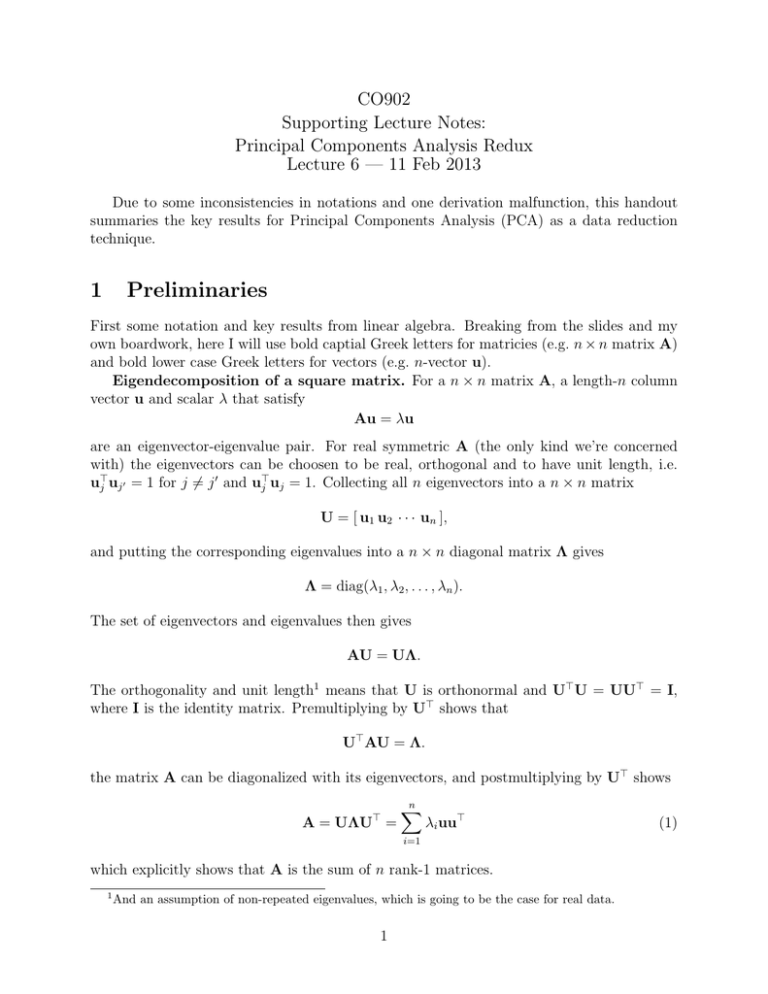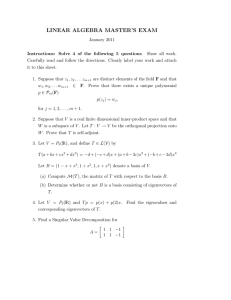CO902 Supporting Lecture Notes: Principal Components Analysis Redux
advertisement

CO902
Supporting Lecture Notes:
Principal Components Analysis Redux
Lecture 6 — 11 Feb 2013
Due to some inconsistencies in notations and one derivation malfunction, this handout
summaries the key results for Principal Components Analysis (PCA) as a data reduction
technique.
1
Preliminaries
First some notation and key results from linear algebra. Breaking from the slides and my
own boardwork, here I will use bold captial Greek letters for matricies (e.g. n × n matrix A)
and bold lower case Greek letters for vectors (e.g. n-vector u).
Eigendecomposition of a square matrix. For a n × n matrix A, a length-n column
vector u and scalar λ that satisfy
Au = λu
are an eigenvector-eigenvalue pair. For real symmetric A (the only kind we’re concerned
with) the eigenvectors can be choosen to be real, orthogonal and to have unit length, i.e.
0
>
u>
j uj 0 = 1 for j 6= j and uj uj = 1. Collecting all n eigenvectors into a n × n matrix
U = [ u1 u2 · · · un ],
and putting the corresponding eigenvalues into a n × n diagonal matrix Λ gives
Λ = diag(λ1 , λ2 , . . . , λn ).
The set of eigenvectors and eigenvalues then gives
AU = UΛ.
The orthogonality and unit length1 means that U is orthonormal and U> U = UU> = I,
where I is the identity matrix. Premultiplying by U> shows that
U> AU = Λ.
the matrix A can be diagonalized with its eigenvectors, and postmultiplying by U> shows
A = UΛU> =
n
X
λi uu>
i=1
which explicitly shows that A is the sum of n rank-1 matrices.
1
And an assumption of non-repeated eigenvalues, which is going to be the case for real data.
1
(1)
2
Unsupervised Learning - Notation
Let the data of interest be length-d column vectors xi , i = 1, . . . , n, assembed into a d × n
data matrix X,
X = [ x1 x2 · · · xn ].
The average data vector is
n
1X
1
x̄ =
xi = X1,
n i=1
n
where 1 is a length-n column vector of ones, and
X − X̄ = [x1 − x̄, x2 − x̄, . . . , xn − x̄] = X −
1
X11>
n
is the centered data matrix. The d × d sample covariance matrix of X is
n
1X
1
S=
(xi − x̄)(xi − x̄)> = (X − X̄)(X − X̄)> .
n i=1
n
(Please make sure you’re comfortable with all these alternative ways of writing the same
expression!)
3
Principal Components Analysis - The crux of it
PCA amounts to finding a k × d matrix U such that the data projected into k dimensions,
yi = U> xi ,
is as “variable” as possible2 . Here, variability is defined by the average squared L2 norm of
yi from its mean, or, equivalently, as the sum of variances in each of the d dimensions.
Writing the k × n reduced data matrix
Y = [ y1 y2 · · · yn ].
and its mean
n
1
1X
yi = Y1,
ȳ =
n i=1
n
this aforementioned variance is
n
n
1X
1X
1
kyi − ȳk2 =
(yi − ȳ)> (yi − ȳ) = tr (Y − Ȳ)(Y − Ȳ)> .
n i=1
n i=1
n
Using the tricks shown in the class notes, you can show that the k dimensional transform U
that maximizes this variance are the first k eigenvectors of S, where eigenvectors are sorted
by eigenvalues, largest to smallest. See, also, the class notes for the derivation of how this
same choice of U minimizes the approximation error for a k dimensional basis set.
2
Note that yi no longer refers to “outcome” or response, as it did with supervised learning.
2
4
Principal Components Analysis - Useful Observations
The class notes show that the optimized variance measure for a k-dimensional PCA is
n
k
X
1X
kyi − ȳk2 =
λj .
n i=1
j=1
That is, the contribution of the variance of the jth compontent is precisely λj . This tells us
the about the relative importance of each component.
Eigenvalue plots. To understand the relative contribution of each component uj , we
make plots of the ordered eigenvalues λj (largest to smallest) and their cumulative variance.
The eigenvalue plot (sometimes called a “scree plot”) shows how much variance explained
by each component. The cumulative variance plot, a graph of
, d
k
X
X
λj
λj
j=1
j=1
versus k, shows the proportion of variance is explained by the first k components. This plot
is useful when thinking of PCA as a k-dimensional representation of the full d dimensional
data.
PCA as a transformation? What if we choose k = d, i.e., made a full-rank transoformation, no data reduction. Then all we’ve done is change coordinates. What is the d × d
sample covariance matrix of this Y? Using the fact Ȳ = Y11> /n = U> X11> /n = U> X̄,
1 >
1
(Y − Ȳ)(Y − Ȳ)> =
(U X − U> X̄)(U> X − U> X̄)>
n
n
1 >
=
U (X − X̄)(X − X̄)> U
n
= U> SU.
= Λ,
where, since k = d, Λ is the d × d diagonal matrix of eigenvectors, using result (1) above.
This shows that when you use a full rank transofmation you “diagonalise” or “whiten” the
data, as the covariances beteween the k = d variables are now zero.
Approximating individual cases. While usually our interest will be working with the
transformed k-dimensional data {yi }, we may want to see what we’ve lost, i.e. how close the
PCA is approximating the data {xi }. The class notes show that data for the i-th case can
be approximated
k
X
x̂i = x̄ +
αij uj
j=1
where αij are the approximating coefficents for case i basis element j,
αij = u>
j (xi − x̄) .
Putting these two together in “matrix mode” gives the approximation for all n cases
X̂ = X̄ + UU> (X − X̄)
3
5
PCA via SVD
The two “take away” messages about PCA are (1) it is the best k-dimensional approximation
(k × n Y) to d dimensional dataset (d × n X), and (2) it is obtained through the eigenvectors
of the d × d sample covariance matrix of X,
1
(X − X̄)(X − X̄)> .
n
Notice that we haven’t made any comment about whether S is invertable? That’s because
it doesn’t matter; we never need to invert S and if d ≥ n S won’t be full rank and one or
more eigenvalues will be zero. No big deal... those would be the last eigenvectors to consider
in an approximation anyway.
A practical issue arises, however, if d n, particularlly when n is very small (10-20) and
d is very large 100 or more. In that case, we are forming a gigantic d × d matrix S when we
know the rank can be no more than n − 1 (not n, due to the centering).
This is where a Singular Value Decomposition (SVD) comes in handy. Often people are
sloppy and interchangeably refer to SVD and PCA, which is wrong. A SVD is a factorisation
of an arbitrary (not necessarily square) matrix; for m × n matrix A, the SVD is
S=
A = UΣV>
where
U: Eigenvectors of AA> ,
V: Eigenvectors of A> A, and
Σ: Diagonal matrix, common eigenvalues of AA> & A> A squared.
So, now consider the SVD of the centered data matrix X − X̄,
X − X̄ = UΣV>
Plug this into the sample variance:
1
(X − X̄)(X − X̄)>
n
1
=
(UΣV> )(UΣV> )>
n
1
=
UΣV> VΣU>
n
1 2
= U
Σ U> .
n
S =
This shows that the the U from the SVD of X − X̄ is exactly the eigenvectors of S, and the
eigenvalues of S relate to the SVD as per
Λjj = Σ2jj /n.
For PCA, this means instead of computing S, we can just submit X − X̄ to a SVD as
long as we get the details right:
4
1. Compute centered data matrix, X − X̄;
2. Compute SVD of X − X̄; only U and Σ are needed; then
3. U are the eigenvectors of S, and
4. diag(Σ2 )/n are the eigenvalues of S, diag(Λ)
In matlab-ese, this means you can do either
[U, D] = eig(S);
or
[U, Dc] = svd(Xcenter); D=Dc.^2/n;
Watch out! The function eig sorts the eigenvalues from smallest to largest, while svd sorts
them largest to smallest.
TEN / February 19, 2013
5







